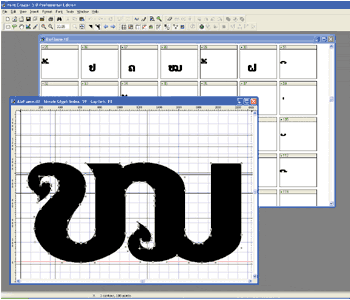|
(Update: April 2011: We have made a change in the keyboard layout which will not affect most people, but which users should be aware of. This is explained at the bottom the page.)
This system has three components:
Keyboard layout: The most common computer keyboard layout in Laos evolved from Lao typewriter layouts, which in turn evolved from Thai typewriter layouts. The two alphabets are quite different, and the layout that resulted from this is inefficient for Lao computer use. You can use this keyboard as part of our entire font system. Or use it as an easier way to type Unicode Lao, using the improved Alo keyboard. The driver you'll need to do that is at Lao Alo Keyboard.
 Fonts: We created some new fonts and revised some existing fonts, so that they look good even when greatly enlarged. We have three families suitable for text, and about a dozen display fonts.
Fonts: We created some new fonts and revised some existing fonts, so that they look good even when greatly enlarged. We have three families suitable for text, and about a dozen display fonts.
Coding: There are various ways to store text within the computer memory. Each system has advantages and disadvantages. We use a way which is very simple and requires no additional programs. You install the font, and begin typing Lao.
Eventually, we expect that most publishing will be done with a different system, called Unicode. However, Unicode doesn't work on some software, or some computers. We are making our system available, free, for anyone interested. We encourage you to download the PDF about the Alo system, and read it before deciding if it is suitable for you. Please understand that all this is free, and we are not able to provide troubleshooting, advice, or support for users.
Explanation of the Alo Lao Font System
This booklet explains how the system works, and the benefits and disadvantages compared to other options. We suggest that you read it before making a decision about what system to use.
Read our PDF about the Alo Font System
Fonts
This picture shows a sample of each font. Beside or below that are links to download the fonts. You may wish to download a few, and try them, before deciding whether to use the system. No other software is needed, simply install and type, but remember that the keyboard (see picture further below) is probably different from what you're currently using.

TEXT:
Alo Mekong:
Medium,
Italic,
Bold,
Bold Italic,
SemiBold
Alo Editor:
Medium,
Italic,
Bold,
Bold Italic
Alo Namkhan:
Medium
Italic,
Bold
Alo NamOu:
Medium,
Italic,
Bold
DISPLAY:
Alo Bravo
Alo Dam
Alo Deua
Alo Egypt
Alo Flame
Alo Freehand
Alo Joy
Alo Lek
Alo SopNok
Alo Spain
Alo TangLuang
Alo Ton Kat
Alo Vera
Keyboard
The Alo keyboard has letters in different places than most Lao keyboards. Some advantages:
1. The "optional Word Break" (top row, after the number 0) key gives you a way to show where a new line can start, but is otherwise invisible.
2. Numbers and common punctuation are in the same location as on a Roman keyboard; this eliminates common problems in many programs.
3. For touch typists (who know where each letter is, without looking), the keyboard is arranged so that the keys most often used are the easiest to reach. This arrangement is about 20% faster for an experienced typist than the most common existing layout (used for Alice, Laos1, and Saysettha). For two-finger typists, who look for each key as they type, the logical groupings of related keys will make it easier to find the letters they want.
Other features:
Locations: Generally, consonants are on the left, vowels on the right, tone marks toward the center. The most commonly used letters are on the middle (third) row.
WB: This key, where the hyphen (-) usually appears, is an optional Word Break. If you put it between words, most computer programs will understand that they can start a new line here if they need to; otherwise this character is invisible.
Numbers and Punctuation: Numbers and all common punctuation are at the same location as on English and most other keyboards.
Old-style Lao numerals: In most programs, you can type old-style Lao-style numerals this way: Add the number you want to 0160, turn on the NUMLOCK key, then hold down ALT while using the numeric keypad (on right) to enter the 4-digit number you want. To get a Lao "3", be sure the NUMLOCK light is on, hold down ALT, and on the numeric keypad enter 0163. For a "0" enter 0170. In Windows, you can also use the "Character Map" utility program.
Tone marks: The lower-case "g" and "h" keys fill most needs for tone marks, if you use the combined vowel-plus-tone-mark keys when they are available. A lower version of tone mark 1 (mai eek), which can be used when there is no raised vowel below it, is at lower-case "b".
The keyboard layout is below. This layout, and a longer discussion of the advantages and disadvantages of various systems, is in the "Read our PDF about the Alo Font System" which can be downloaded above.

Font Switching
Each Alo font also includes a full Roman (English) alphabet, so that if you need a single letter or word in English, you don't need to change fonts. In Windows, you can also use the "Character Map" utility program to get access to the English. If you often need to switch between fonts, the following utility makes it simple. Although this has proven easy to install for people with some computer experience, we suggest that you try out the Alo system, and see if you want to use it, before you decide if you need the font-switching.
If you wish to use the font-switching, you will need these two small downloads. Click, and tell your computer to SAVE them; DO NOT RUN THEM YET. The booklet above tells how to install this utility.
Item one: AloEN.msi
Item two: AloEN.dll
Converting text: You can now convert between Alo and the two other common systems: UniCode and Saysettha 2000, at www.anotherurl.com/laofont/.)
|

